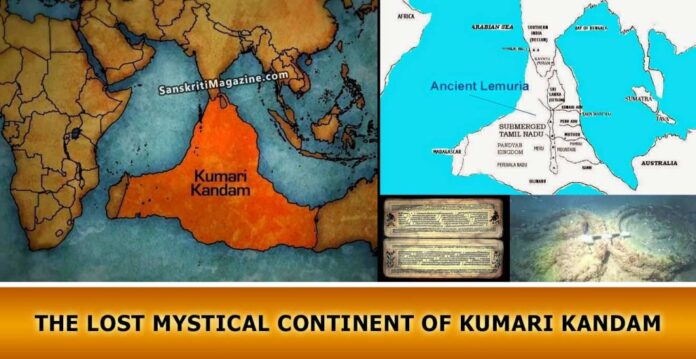Ravana Lanka: For centuries, the Indian subcontinent has been the birthplace of countless myths, ancient wisdom, and legendary civilizations. Among the most intriguing of these is the tale of Ravana’s Lanka—a golden kingdom described in the Valmiki Ramayana with such opulence and grandeur that it often blurs the line between mythology and reality. But what if Lanka wasn’t just a mythical island? What if it was part of a lost continent—Kumari Kandam—submerged in the depths of the Indian Ocean?
This article takes a deep dive into that possibility, exploring ancient texts, scientific theories, and modern discoveries that could reshape how we understand both history and legend.
🏯 The Lanka of Ravana: As Described in the Ramayana
According to the Valmiki Ramayana, Lanka was no ordinary city. It was depicted as a majestic kingdom of golden palaces, soaring towers, advanced engineering, and an immensely powerful king—Ravana. Rama’s vanara (monkey) army is said to have constructed the legendary “Setubandha” (Ram Setu) across the ocean to reach Lanka.
One striking detail in the epic is that Lanka was situated 100 yojanas (approximately 1,200 km) from the Indian mainland. This is much farther than the modern-day distance between Rameswaram (India) and Mannar (Sri Lanka), which is only about 30 to 50 km. This raises a serious question—was the Lanka of the Ramayana truly located in present-day Sri Lanka? Or was it somewhere else entirely?
🌊 Kumari Kandam: The Lost Continent Beneath the Indian Ocean
Enter the legend of Kumari Kandam, also known in Western literature as Lemuria. This hypothesized submerged landmass is deeply rooted in ancient Tamil literature and cultural memory. It is believed to have existed south of present-day India and may have once connected parts of Africa, India, and Australia.
Key references in Tamil literature:
- Tolkappiyam, one of the oldest Tamil grammatical works, references a vast lost land to the south.
- Poets like Kaniyan Poongundranar refer to lands swallowed by the sea.
- Sangam literature contains vivid accounts of floods that destroyed ancient cities and kingdoms.
Kumari Kandam is believed to have been the cradle of early Tamil civilization, with advanced knowledge in science, art, literature, astronomy, and spirituality. Over time, the land is said to have sunk beneath the ocean due to cataclysmic geological events.
🧭 Geological Clues and Scientific Hints
Although mainstream science remains cautious, certain geological and oceanographic findings lend limited support to the possibility of submerged civilizations in the Indian Ocean.
Some key discoveries and theories include:
- Submerged landmasses have been found beneath the Indian Ocean through sonar mapping and underwater expeditions.
- The Ram Setu (Adam’s Bridge), visible in satellite imagery, is a chain of limestone shoals connecting India and Sri Lanka. Some scientists believe it may be a natural formation, but others argue it shows signs of human intervention, consistent with the epic’s descriptions.
- Dwarka, an ancient city discovered underwater near the coast of Gujarat, is estimated to be over 9,000 years old, reinforcing the idea that ancient civilizations once flourished and disappeared beneath the sea.
- Tectonic plate movements and changes in sea levels have been well-documented over geological timescales, making the idea of a sunken landmass like Kumari Kandam geologically plausible.
🔍 Scholars and Theorists: Divided But Intrigued
There are two primary schools of thought regarding Ravana’s Lanka and Kumari Kandam:
1. The Traditionalist View:
Scholars of ancient literature and spiritual traditions argue that Ravana’s Lanka was indeed part of Kumari Kandam. They cite the detailed descriptions in the Ramayana and Sangam literature as cultural memory of a real place. According to them, Lanka’s location in the deep southern seas aligns more with the lost continent theory than with modern-day Sri Lanka.
2. The Scientific View:
Most scientists maintain a skeptical stance, stating that while there is some geological evidence of landmass submergence, there is no concrete archaeological evidence linking these submerged features directly to Ravana’s Lanka or Kumari Kandam. Nonetheless, they acknowledge that the presence of underwater structures and unusual formations warrants further exploration.
🔬 Technology’s Role in Unraveling the Mystery
Modern technology has opened new doors for uncovering ancient secrets that once seemed lost forever:
- LIDAR (Light Detection and Ranging) allows researchers to scan ocean floors with high precision.
- Deep-sea robotic probes can explore submerged ruins where divers cannot reach.
- Satellite imaging and geo-magnetic surveys are helping to map anomalies under the sea that could point to man-made structures.
- Indian organizations like NIOT (National Institute of Ocean Technology) and ISRO have been working on projects aimed at studying undersea features that could reshape our understanding of ancient Indian history.
As these tools evolve, the possibility of discovering long-lost cities, trade routes, or even entire civilizations hidden beneath the waves becomes more realistic.
🧩 Connecting Mythology and Science
What makes this topic so fascinating is how it merges mythology, ancient literature, and modern science into one compelling narrative. If Kumari Kandam can be scientifically proven to have existed, and if evidence emerges connecting it with Lanka, it could rewrite not just Indian history but human history.
The Valmiki Ramayana may no longer be viewed solely as an epic poem—it might be seen as a coded historical account, preserving in allegorical form the memory of a real place and time.
⚖️ Final Thoughts: Myth or Memory?
So, was Ravana’s Lanka a magnificent kingdom built on a now-submerged continent? Was Kumari Kandam the heart of a once-great civilization that disappeared beneath the ocean? At this stage, we don’t have definitive answers—but we do have growing clues.
As scientific curiosity intersects with cultural legacy, the quest for truth continues. Perhaps in the near future, with the aid of technology and interdisciplinary research, we may finally lift the veil on one of the greatest mysteries of ancient India.
Until then, the legend of Lanka and the lost land of Kumari Kandam remains an enduring mystery—one that beckons explorers, historians, and dreamers alike.
Read More: Escape the City: Discover the Enchanting Bhetia Waterfalls Near Kolkata This Monsoon








[…] Read More: In Search of Ravana’s Lanka: Was the Lost Continent of Kumari Kandam Its True Home? […]